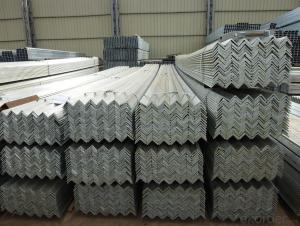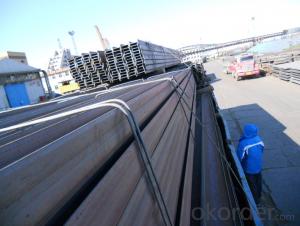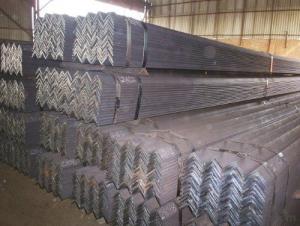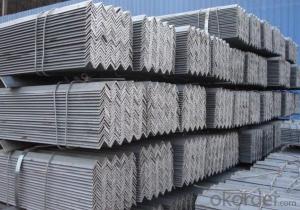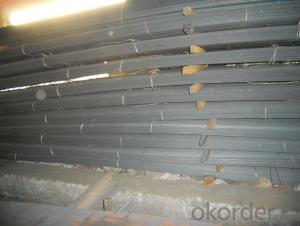Equal Angle Steel Prime Hot Rolled for Construction
- Loading Port:
- Tianjin
- Payment Terms:
- TT or LC
- Min Order Qty:
- 25 m.t.
- Supply Capability:
- 40000 m.t./month
OKorder Service Pledge
OKorder Financial Service
You Might Also Like
Product Description:
OKorder is offering Equal Angle Steel Prime Hot Rolled for Construction at great prices with worldwide shipping. Our supplier is a world-class manufacturer of steel, with our products utilized the world over. OKorder annually supplies products to European, North American and Asian markets. We provide quotations within 24 hours of receiving an inquiry and guarantee competitive prices.
Product Applications:
Equal Angle Steel Prime Hot Rolled for Construction are ideal for structural applications and are widely used in the construction of buildings and bridges, and the manufacturing, petrochemical, and transportation industries.
Product Advantages:
OKorder's Equal Angle Steel Prime Hot Rolled for Construction are durable, strong, and resist corrosion.
Main Product Features:
· Premium quality
· Prompt delivery & seaworthy packing (30 days after receiving deposit)
· Corrosion resistance
· Can be recycled and reused
· Mill test certification
· Professional Service
· Competitive pricing
Product Specifications:
Hot Rolled Equal Angle Steel
1.Professional factory
2.Angle steel Size:20-200MM
3.Angle steel Standard:JIS
4.Materials:SS400
Commodity Size(mm) Theoretical Weight(kg/m)
EQUAL ANGLE 20*20*3 0.889
EQUAL ANGLE 20*20*4 1.145
EQUAL ANGLE 25*25*2.5 0.932
EQUAL ANGLE 25*25*2.7 1.003
EQUAL ANGLE 25*25*3.0 1.124
EQUAL ANGLE 25*25*4.0 1.459
EQUAL ANGLE 30*30*2.5 1.128
EQUAL ANGLE 30*30*3.0 1.373
EQUAL ANGLE 30*30*4.0 1.786
EQUAL ANGLE 35*35*3.0 1.578
EQUAL ANGLE 35*35*4.0 2.072
EQUAL ANGLE 35*35*5.0 2.551
EQUAL ANGLE 38*38*2.5 1.442
EQUAL ANGLE 38*38*3.0 1.719
EQUAL ANGLE 38*38*3.7 2.100
EQUAL ANGLE 38*38*4.0 2.261
EQUAL ANGLE 40*40*3.0 1.852
EQUAL ANGLE 40*40*4.0 2.422
EQUAL ANGLE 40*40*5.0 2.976
EQUAL ANGLE 48*48*3.0 2.190
EQUAL ANGLE 48*48*4.0 2.889
EQUAL ANGLE 48*48*5.0 3.572
EQUAL ANGLE 50*50*3.0 2.332
EQUAL ANGLE 50*50*3.7 2.797
EQUAL ANGLE 50*50*4.0 3.059
EQUAL ANGLE 50*50*5.0 3.770
EQUAL ANGLE 50*50*6.0 4.465
EQUAL ANGLE 56*56*3.0 2.624
EQUAL ANGLE 56*56*4.0 3.446
EQUAL ANGLE 56*56*5.0 4.251
EQUAL ANGLE 60*60*5.0 4.514
EQUAL ANGLE 60*60*6.0 5.369
EQUAL ANGLE 63*63*4.0 3.907
EQUAL ANGLE 63*63*5.0 4.822
EQUAL ANGLE 63*63*6.0 5.721
EQUAL ANGLE 63*63*8.0 7.469
EQUAL ANGLE 63*63*10.0 9.151
EQUAL ANGLE 70*70*4.0 4.372
EQUAL ANGLE 70*70*5.0 5.397
EQUAL ANGLE 70*70*6.0 6.406
EQUAL ANGLE 70*70*7.0 7.398
EQUAL ANGLE 70*70*8.0 8.373
EQUAL ANGLE 75*75*5.0 5.818
EQUAL ANGLE 75*75*6.0 6.905
EQUAL ANGLE 75*75*7.0 7.976
EQUAL ANGLE 75*75*8.0 9.030
EQUAL ANGLE 75*75*10.0 11.089
EQUAL ANGLE 80*80*5.0 6.211
EQUAL ANGLE 80*80*6.0 7.376
EQUAL ANGLE 80*80*7.0 8.525
EQUAL ANGLE 80*80*8.0 9.658
EQUAL ANGLE 80*80*10.0 11.874
EQUAL ANGLE 90*90*6.0 8.350
EQUAL ANGLE 90*90*7.0 9.656
EQUAL ANGLE 90*90*8.0 10.946
EQUAL ANGLE 90*90*9.0 12.081
EQUAL ANGLE 90*90*10.0 13.476
EQUAL ANGLE 90*90*12.0 15.940
EQUAL ANGLE 100*100*6 9.366
EQUAL ANGLE 100*100*7 10.830
EQUAL ANGLE 100*100*8 12.276
EQUAL ANGLE 100*100*9 13.494
EQUAL ANGLE 100*100*10 15.120
EQUAL ANGLE 100*100*12 17.898
EQUAL ANGLE 100*100*14 20.611
EQUAL ANGLE 100*100*16 23.257
EQUAL ANGLE 110*110*7 11.928
EQUAL ANGLE 110*110*8 13.532
EQUAL ANGLE 110*110*10 16.690
EQUAL ANGLE 110*110*12 19.782
EQUAL ANGLE 110*110*14 22.809
EQUAL ANGLE 120*120*10.0 18.055
EQUAL ANGLE 120*120*12.0 21.478
EQUAL ANGLE 125*125*8 15.504
EQUAL ANGLE 125*125*10 19.133
EQUAL ANGLE 125*125*12 22.696
EQUAL ANGLE 125*125*14 26.193
EQUAL ANGLE 130*130*10 19.625
EQUAL ANGLE 130*130*12 23.362
EQUAL ANGLE 140*140*10 21.488
EQUAL ANGLE 140*140*12 25.522
EQUAL ANGLE 140*140*14 29.490
EQUAL ANGLE 140*140*16 33.393
EQUAL ANGLE 150*150*10.0 22.765
EQUAL ANGLE 150*150*12.0 27.130
EQUAL ANGLE 150*150*15.0 33.559
EQUAL ANGLE 160*160*10.0 24.719
EQUAL ANGLE 160*160*12.0 29.391
EQUAL ANGLE 160*160*14.0 33.987
EQUAL ANGLE 160*160*16.0 38.518
EQUAL ANGLE 180*180*12.0 33.159
EQUAL ANGLE 180*180*14.0 35.383
EQUAL ANGLE 180*180*16.0 43.542
EQUAL ANGLE 180*180*18.0 48.634
EQUAL ANGLE 200*200*14.0 42.894
EQUAL ANGLE 200*200*15.0 45.334
EQUAL ANGLE 200*200*16.0 48.680
EQUAL ANGLE 200*200*18.0 54.401
EQUAL ANGLE 200*200*20.0 60.056
EQUAL ANGLE 200*200*22.0 65.281
EQUAL ANGLE 200*200*24.0 71.168
FAQ:
Q1: Why buy Materials & Equipment from OKorder.com?
A1: All products offered byOKorder.com are carefully selected from China's most reliable manufacturing enterprises. Through its ISO certifications, OKorder.com adheres to the highest standards and a commitment to supply chain safety and customer satisfaction.
Q2: How do we guarantee the quality of our products?
A2: We have established an advanced quality management system which conducts strict quality tests at every step, from raw materials to the final product. At the same time, we provide extensive follow-up service assurances as required.
Q3: How soon can we receive the product after purchase?
A3: Within three days of placing an order, we will begin production. The specific shipping date is dependent upon international and government factors, but is typically 7 to 10 workdays.
Q4: What makes stainless steel stainless?
A4: Stainless steel must contain at least 10.5 % chromium. It is this element that reacts with the oxygen in the air to form a complex chrome-oxide surface layer that is invisible but strong enough to prevent further oxygen from "staining" (rusting) the surface. Higher levels of chromium and the addition of other alloying elements such as nickel and molybdenum enhance this surface layer and improve the corrosion resistance of the stainless material.
Q5: Can stainless steel rust?
A5: Stainless does not "rust" as you think of regular steel rusting with a red oxide on the surface that flakes off. If you see red rust it is probably due to some iron particles that have contaminated the surface of the stainless steel and it is these iron particles that are rusting. Look at the source of the rusting and see if you can remove it from the surface.
Images:


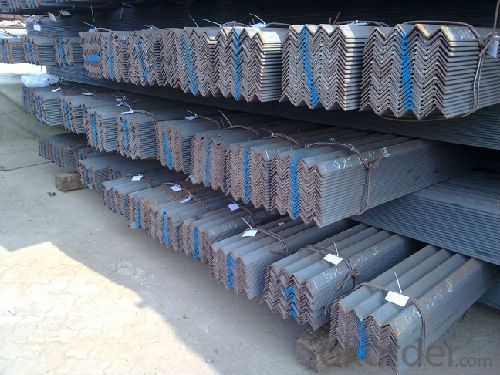
- Q: What are the different types of steel angles available?
- There are several different types of steel angles available, each designed for specific applications and purposes. Some common types include: 1. Equal Angle: Also known as L-shaped angles, these steel angles have equal side lengths and are often used for general structural and construction purposes. They provide excellent support and stability when connected to other structural components. 2. Unequal Angle: As the name suggests, unequal angles have different side lengths. These angles are commonly used in applications where one side needs to be longer or shorter than the other, such as supporting uneven loads or creating specific shapes. 3. Stainless Steel Angle: These angles are made from stainless steel, which is highly resistant to corrosion, making them suitable for applications where exposure to moisture or chemicals is a concern. They are often used in food processing plants, chemical industries, and marine environments. 4. Galvanized Angle: Galvanized steel angles are coated with a layer of zinc, providing excellent corrosion resistance. This makes them ideal for outdoor applications or areas with high humidity or saltwater exposure. 5. Rolled Steel Angle: Rolled steel angles are manufactured by rolling hot-rolled steel into the desired shape. This process enhances the strength and durability of the angle, making it suitable for heavy-duty applications. 6. Slotted Angle: Slotted angles have holes or slots along their length, allowing for easy attachment and adjustment. They are commonly used in shelving systems, workbenches, and storage racks, as they offer a versatile and customizable solution. 7. Structural Steel Angle: These angles are typically used in construction projects requiring load-bearing support. They are designed to withstand heavy loads and provide structural stability in buildings, bridges, and other infrastructure projects. It is important to consider the specific requirements of your project before choosing the appropriate type of steel angle. Consulting with a structural engineer or steel supplier can ensure that you select the right angle for your application.
- Q: Can steel angles be used in telecommunications towers?
- Certainly, telecommunications towers can incorporate steel angles. Due to their robustness, longevity, and cost efficiency, steel angles are frequently employed in the construction of telecommunications towers. They are commonly utilized within the tower's framework to deliver stability and structural reinforcement. The exceptional tensile strength of steel angles enables them to withstand substantial loads, intense winds, and various environmental elements that telecommunication towers may confront. Moreover, the adaptability of steel angles permits customization and seamless installation, rendering them a favored option within the telecommunications sector.
- Q: Can steel angles be used as supports for overhead doors or garage doors?
- Indeed, overhead doors or garage doors can rely on steel angles as their supports. Due to their impressive strength and durability, steel angles are frequently employed in construction. They offer superb support and stability for hefty doors, making them an ideal selection for overhead or garage doors. By securely fastening the angles to the walls or framework, a sturdy foundation is provided for the doors to hang on and function seamlessly. Moreover, steel angles can be tailored to fit the precise dimensions and weight prerequisites of the doors, guaranteeing adequate support and functionality.
- Q: What is the meaning of the number of angle steel
- Angle called angle, the steel strip is perpendicular to each other on both sides into the corner. The angle iron can be made up of different force components according to the different structure, and can also be used as the connecting piece between the components.
- Q: How do steel angles behave under seismic forces?
- Steel angles behave differently under seismic forces depending on their design, size, and connection details. Generally, steel angles are commonly used in seismic-resistant structures due to their ability to dissipate energy and resist lateral forces. Here are some key characteristics of how steel angles behave under seismic forces: 1. Ductility: Steel angles exhibit high ductility, which allows them to undergo large deformations without failure. This property is crucial in seismic design as it allows the structure to absorb and dissipate energy during an earthquake, preventing sudden collapse. 2. Flexibility: Steel angles have the ability to flex and bend under seismic forces, allowing them to absorb energy and reduce the impact on the overall structure. This flexibility helps in distributing the seismic forces throughout the structure, minimizing localized damage. 3. Connection behavior: Proper connection design is crucial to ensure the performance of steel angles under seismic forces. The connections should be designed to allow for rotation and accommodate the expected displacements during an earthquake. Adequate connections prevent the angles from becoming brittle or failing prematurely. 4. Buckling resistance: Steel angles are susceptible to buckling under compression forces. To enhance their buckling resistance, lateral bracing or stiffeners are often used. These elements provide additional support to the angles and help prevent buckling during seismic events. 5. Strength and stiffness: Steel angles have high strength and stiffness, which allows them to resist the lateral forces induced by an earthquake. The strength of steel angles can be enhanced through proper material selection, such as using higher-grade steel with greater yield strength. Overall, steel angles are well-suited for seismic-resistant structures due to their ductility, flexibility, and strength. However, their behavior under seismic forces heavily relies on proper design, connection details, and adherence to seismic codes and standards. It is essential to consult with structural engineers and follow best practices to ensure the optimal performance of steel angles in seismic design.
- Q: What is the maximum deflection allowed for a steel angle?
- The maximum deflection allowed for a steel angle depends on various factors such as the specific application, the load applied, and the desired safety factor. However, as a general guideline, the maximum deflection allowed for a steel angle is typically limited to 1/360th of its span length.
- Q: What are the maximum allowable deflections for steel angles?
- The maximum allowable deflections for steel angles depend on various factors such as the specific application, loadings, and design codes or standards being followed. However, in general, deflections for steel angles should be within acceptable limits to ensure structural integrity and safety. It is recommended to consult relevant design codes, standards, or structural engineers to determine the specific maximum allowable deflections for steel angles in a given situation.
- Q: How do you prevent steel angles from rusting?
- There are several methods to prevent steel angles from rusting: 1. Protective Coatings: Applying a protective coating on the surface of steel angles is an effective way to prevent rust formation. Common coating options include paint, epoxy, enamel, and galvanized coatings. These coatings act as a barrier, preventing moisture and oxygen from reaching the steel surface, thus minimizing the chances of rusting. 2. Rust Inhibitors: Rust inhibitors are chemical compounds that can be applied to steel angles to prevent rust formation. These inhibitors work by either forming a protective layer on the steel surface or by actively inhibiting the corrosion process. Rust inhibitors can be applied as sprays, coatings, or even added to the steel during the manufacturing process. 3. Proper Storage and Handling: One of the simplest ways to prevent rust is to store and handle steel angles properly. This includes keeping them in a dry environment, preferably indoors or under a protective covering, to avoid exposure to moisture and humidity. Additionally, handling steel angles with clean, dry gloves can prevent the transfer of moisture from hands, which can accelerate the rusting process. 4. Regular Maintenance: Regular inspection and maintenance of steel angles can help identify and address any signs of rust formation at an early stage. Promptly addressing any rust spots by removing them with wire brushes or sandpaper and applying touch-up coatings can prevent further corrosion. 5. Dry Storage and Proper Ventilation: If steel angles are stored outdoors, it is crucial to ensure they are placed in a well-ventilated area to promote air circulation and prevent the accumulation of moisture. Furthermore, covering the angles with a waterproof tarp or plastic wrap can provide an additional layer of protection against rain, snow, and other weather elements. By implementing a combination of these preventive measures, steel angles can be safeguarded against rust formation, ensuring their longevity and structural integrity.
- Q: What are the common corrosion protection methods for steel angles?
- Common corrosion protection methods for steel angles include applying protective coatings such as paint or zinc coatings, using corrosion inhibitors, electroplating, hot-dip galvanizing, and powder coating. These methods help to prevent or slow down the corrosion process and extend the lifespan of the steel angles.
- Q: What is the maximum spacing for steel angles in a support structure?
- The spacing of steel angles in a support structure is dependent on various factors, such as the load being supported, the size and thickness of the angles, and the design criteria specific to the project. Generally, the spacing between steel angles should be determined by the structural engineer or designer based on the maximum allowable deflection and stress criteria for the given application. Steel angles are commonly utilized in support structures due to their strength and versatility. They offer stability and support to different types of loads. However, excessive spacing between steel angles can result in increased deflection and stress on the structure, potentially compromising its integrity. To establish the maximum spacing, the engineer will take into account the load-bearing capacity of the steel angles, the expected load distribution, and any relevant building codes or industry standards. The specific design criteria will dictate the allowable deflection and stress limits, which will then be utilized to calculate the appropriate spacing between the angles. It is important to note that different support structures may have varying requirements for maximum spacing. For example, in a roof truss system, the maximum spacing between steel angles may be smaller compared to a mezzanine support structure. Furthermore, the maximum spacing may differ depending on whether the angles are used as primary or secondary support members. Ultimately, the determination of the maximum spacing for steel angles in a support structure should be done through a comprehensive engineering analysis, taking into consideration the specific project requirements and safety factors. It is always advisable to consult with a structural engineer or design professional to ensure that the support structure meets all necessary safety and performance criteria.
Send your message to us
Equal Angle Steel Prime Hot Rolled for Construction
- Loading Port:
- Tianjin
- Payment Terms:
- TT or LC
- Min Order Qty:
- 25 m.t.
- Supply Capability:
- 40000 m.t./month
OKorder Service Pledge
OKorder Financial Service
Similar products
Hot products
Hot Searches
Related keywords
